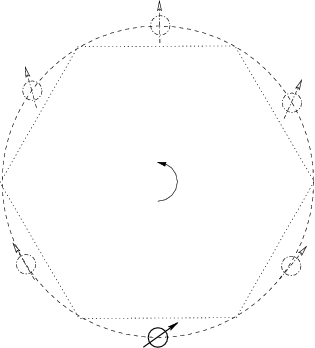 |
The relativists permanently emphasize that the Newtonian mechanics does not describe anything as compared to SRT. For example, in the book [33] the so-called Thomas precession is considered (which represents the effect of turning a rod in SRT as the manifestation of the "relativity of simultaneity"). It is also alleged in this book that in the Newtonian mechanics the gyroscope always keeps its attitude. However, as known from the quantum mechanics, the electron spin moment is always directed either along, or against the direction of orbital moment. That is, in the given case it is perpendicular to the orbital plane (and to the electron velocity!). And in this generally-accepted case both the Newtonian mechanics and SRT conserve the gyroscope direction perpendicular to the orbital plane. Therefore, the varying spin directions, shown in the book [33], do not meet the reality (Fig. 4.7).
If, nevertheless, we suppose the electron spin attitude to be slant and recall, that we have not simply a gyroscope (a rotating ball), but a charged particle that possesses magnetic moment, then in the magnetic field of a charged nucleon under an effect of forces the electron spin precession will be observed, which can be described in the classical manner (as far as it is possible to be done for microscopic world's objects). For classical description of the given phenomenon (without SRT interpretations) it is necessary to know all atomic parameters, including the attitudes of spins and moments. Moreover, in the classical case, even if the electron spin attitude is perpendicular to the orbit, the precession is possible, if the nucleon moment is not perpendicular to the orbit (the nucleon can precess too). A concordance of all motions, including all orbits, all precessions, displacements of all perihelions, takes place in any real many-body problem always.
The modern use of the particles' spin concept is intrinsically inconsistent in SRT. The fact is, that at collisions the particles move relative to each other and, in addition, change their motion. And in a moving system the angular momentum (both orbital, and the spin) must, according to SRT, differ from the same quantity in a resting system. And how can the spin remain to be invariant and participate in rigorous numerical equalities (conservation laws)?
Besides, the Thomas precession as a kinematic effect of SRT is intrinsically contradictory (see Chapter 1), since this rotation process is beyond the scope of SRT inertial systems (of rectilinear uniform motion).